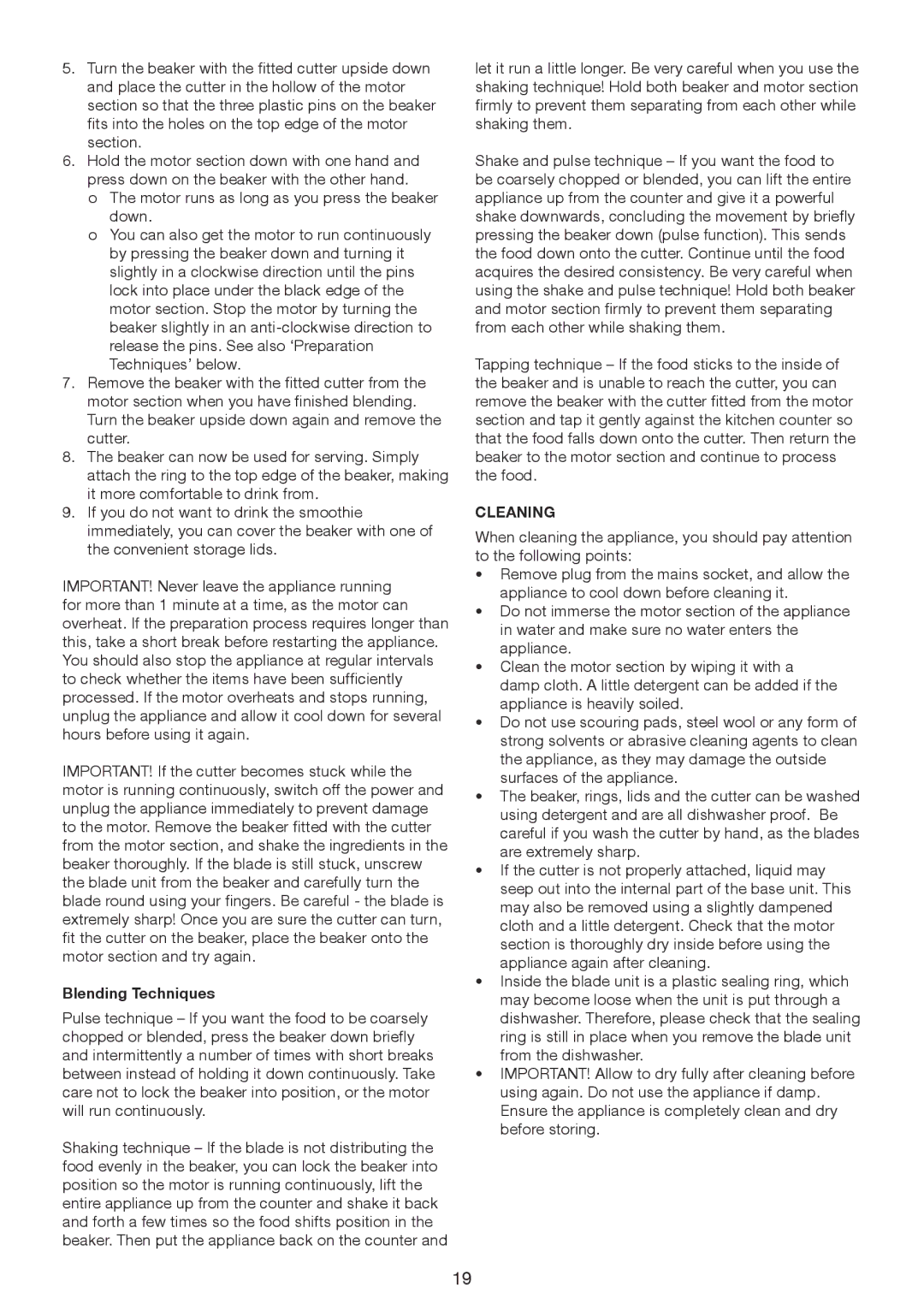5.Turn the beaker with the fitted cutter upside down and place the cutter in the hollow of the motor section so that the three plastic pins on the beaker fits into the holes on the top edge of the motor section.
6.Hold the motor section down with one hand and press down on the beaker with the other hand.
o The motor runs as long as you press the beaker down.
o You can also get the motor to run continuously by pressing the beaker down and turning it slightly in a clockwise direction until the pins lock into place under the black edge of the motor section. Stop the motor by turning the beaker slightly in an anti-clockwise direction to release the pins. See also ‘Preparation
Techniques’ below.
7.Remove the beaker with the fitted cutter from the motor section when you have finished blending.
Turn the beaker upside down again and remove the cutter.
8.The beaker can now be used for serving. Simply attach the ring to the top edge of the beaker, making it more comfortable to drink from.
9.If you do not want to drink the smoothie immediately, you can cover the beaker with one of the convenient storage lids.
IMPORTANT! Never leave the appliance running for more than 1 minute at a time, as the motor can overheat. If the preparation process requires longer than this, take a short break before restarting the appliance. You should also stop the appliance at regular intervals to check whether the items have been sufficiently processed. If the motor overheats and stops running, unplug the appliance and allow it cool down for several hours before using it again.
IMPORTANT! If the cutter becomes stuck while the motor is running continuously, switch off the power and unplug the appliance immediately to prevent damage to the motor. Remove the beaker fitted with the cutter from the motor section, and shake the ingredients in the beaker thoroughly. If the blade is still stuck, unscrew the blade unit from the beaker and carefully turn the blade round using your fingers. Be careful - the blade is extremely sharp! Once you are sure the cutter can turn, fit the cutter on the beaker, place the beaker onto the motor section and try again.
Blending Techniques
Pulse technique – If you want the food to be coarsely chopped or blended, press the beaker down briefly and intermittently a number of times with short breaks between instead of holding it down continuously. Take care not to lock the beaker into position, or the motor will run continuously.
Shaking technique – If the blade is not distributing the food evenly in the beaker, you can lock the beaker into position so the motor is running continuously, lift the entire appliance up from the counter and shake it back and forth a few times so the food shifts position in the beaker. Then put the appliance back on the counter and
let it run a little longer. Be very careful when you use the shaking technique! Hold both beaker and motor section firmly to prevent them separating from each other while shaking them.
Shake and pulse technique – If you want the food to be coarsely chopped or blended, you can lift the entire appliance up from the counter and give it a powerful shake downwards, concluding the movement by briefly pressing the beaker down (pulse function). This sends the food down onto the cutter. Continue until the food acquires the desired consistency. Be very careful when using the shake and pulse technique! Hold both beaker and motor section firmly to prevent them separating from each other while shaking them.
Tapping technique – If the food sticks to the inside of the beaker and is unable to reach the cutter, you can remove the beaker with the cutter fitted from the motor section and tap it gently against the kitchen counter so that the food falls down onto the cutter. Then return the beaker to the motor section and continue to process the food.
CLEANING
When cleaning the appliance, you should pay attention to the following points:
•Remove plug from the mains socket, and allow the appliance to cool down before cleaning it.
•Do not immerse the motor section of the appliance in water and make sure no water enters the appliance.
•Clean the motor section by wiping it with a damp cloth. A little detergent can be added if the appliance is heavily soiled.
•Do not use scouring pads, steel wool or any form of strong solvents or abrasive cleaning agents to clean the appliance, as they may damage the outside surfaces of the appliance.
•The beaker, rings, lids and the cutter can be washed using detergent and are all dishwasher proof. Be careful if you wash the cutter by hand, as the blades are extremely sharp.
•If the cutter is not properly attached, liquid may seep out into the internal part of the base unit. This may also be removed using a slightly dampened cloth and a little detergent. Check that the motor section is thoroughly dry inside before using the appliance again after cleaning.
•Inside the blade unit is a plastic sealing ring, which may become loose when the unit is put through a dishwasher. Therefore, please check that the sealing ring is still in place when you remove the blade unit from the dishwasher.
•IMPORTANT! Allow to dry fully after cleaning before using again. Do not use the appliance if damp. Ensure the appliance is completely clean and dry before storing.
